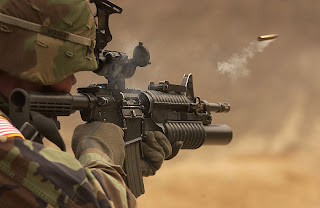 |
| Wikimedia Commons Image |
WASHINGTON (AFP) – The United States stepped aside to allow NATO to run Libya no-fly operations, but the US military’s enormous strike power remains the real muscle behind the coalition effort.
Having held back before plunging into a mission with ill-defined objectives, Washington took the reins Saturday of a coalition tasked rather ambiguously with using “all necessary measures” to protect Libyan civilians.
President Barack Obama, who is under fire from Republicans at home for entering a conflict without a clear exit strategy or endgame, wants to transfer command as quickly as possible to European and Arab allies.
Obama is wary about how America will be perceived in the Arab world, particularly given the current turmoil sweeping the Middle East and North Africa, and also the damage done by his predecessor’s invasion of Iraq.
US Secretary of State Hillary Clinton applauded NATO’s decision to take command of no-fly operations and hinted a deal was in the works for the transatlantic military alliance to take broader control of all operations.
“We have agreed, along with our NATO allies, to transition command and control for the no-fly zone over Libya to NATO. All 28 allies have also now authorized military authorities to develop an operations plan for NATO to take on the broader civilian protection mission under Resolution 1973.”
But Muslim-majority member Turkey has balked at giving NATO command of strikes on ground targets and NATO Secretary General Anders Fogh Rasmussen suggested further discussions would be required over the weekend.
“At the moment, there will still be a coalition operation and a NATO operation,” Rasmussen said.
US Vice Admiral Bill Gortney meanwhile said the Pentagon was “working very hard on the military side to be able to hand over the lead of this operation to a coalition command structure as early as this weekend.”
All this does not exactly send a clear message to Libyan strongman Moamer Kadhafi that the coalition is united and in the battle for the long haul.
After sustaining almost one week of air and missile strikes, loyalist forces show no sign of the large-scale mutinies the predominantly Western alliance was clearly hoping for, and Kadhafi appears to be digging in.
 The command debate, however, may be more for political show than about real changes on the ground if NATO eventually does take the mantle, according to Lawrence Korb, from the Center for American Progress think-tank.
The command debate, however, may be more for political show than about real changes on the ground if NATO eventually does take the mantle, according to Lawrence Korb, from the Center for American Progress think-tank.
“It will help to change the perception of the operation,” particularly in the Arab world, Korb told AFP. “The US is a critical part of the operation but we want to do it behind the scene.”
French jets dropped the first bombs in the conflict before Tomahawk cruise missiles followed from US and British submarines.
Now the 12-country coalition includes Belgium, Canada, Denmark, Italy, Norway, Qatar, Spain, Turkey and the United Arab Emirates.
More than half the 350 aircraft involved belong to the United States, but Gortney said that over the preceding 24 hours partner nations had flown “roughly half” of the 130 coalition sorties.
Twenty-six of the 38 ships in the Gulf of Sirte enforcing the UN arms embargo — also under NATO command — are from other countries, and Turkey has now offered five ships and a submarine.
But with several submarines, destroyers, the USS Mount Whitney command-and-control vessel, specialized surveillance aircraft as well as its fleet of fighter jets, the United States — also the main contributor to NATO — will remain at the heart of operations.
“The phrase that we use is that the United States will contribute its unique military capabilities to whatever this second phase of operation would be,” General Carter Ham, the commander of US forces, told ABC News.
“There’s probably some intelligence support that we would continue to provide, some communications, tankers for aircraft…. But we wouldn’t see probably a large number of fighter aircraft for example.”
Ham said he was confident command could be handed over “relatively quickly” but admitted there were some “very, very complex” procedures, especially with air operations, that might lengthen that transition period.
© AFP — Published at Activist Post with license
linkwithin_text=’Related Articles:’


Be the first to comment on "US remains military muscle in Libya campaign"